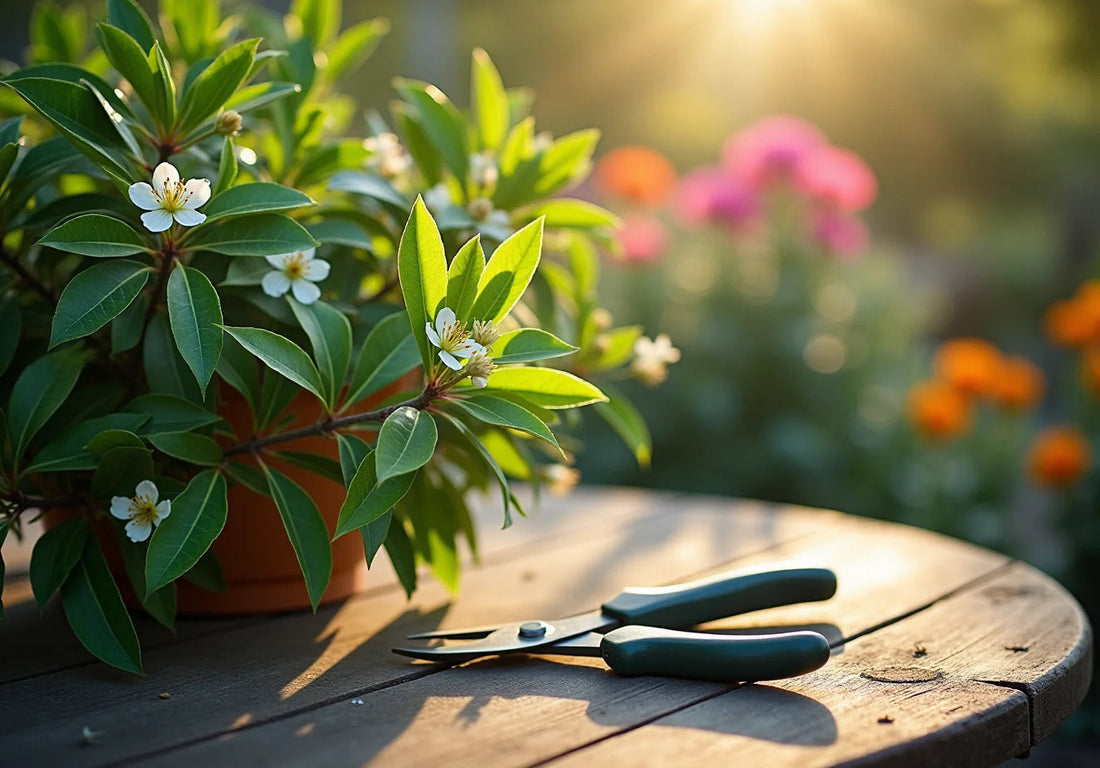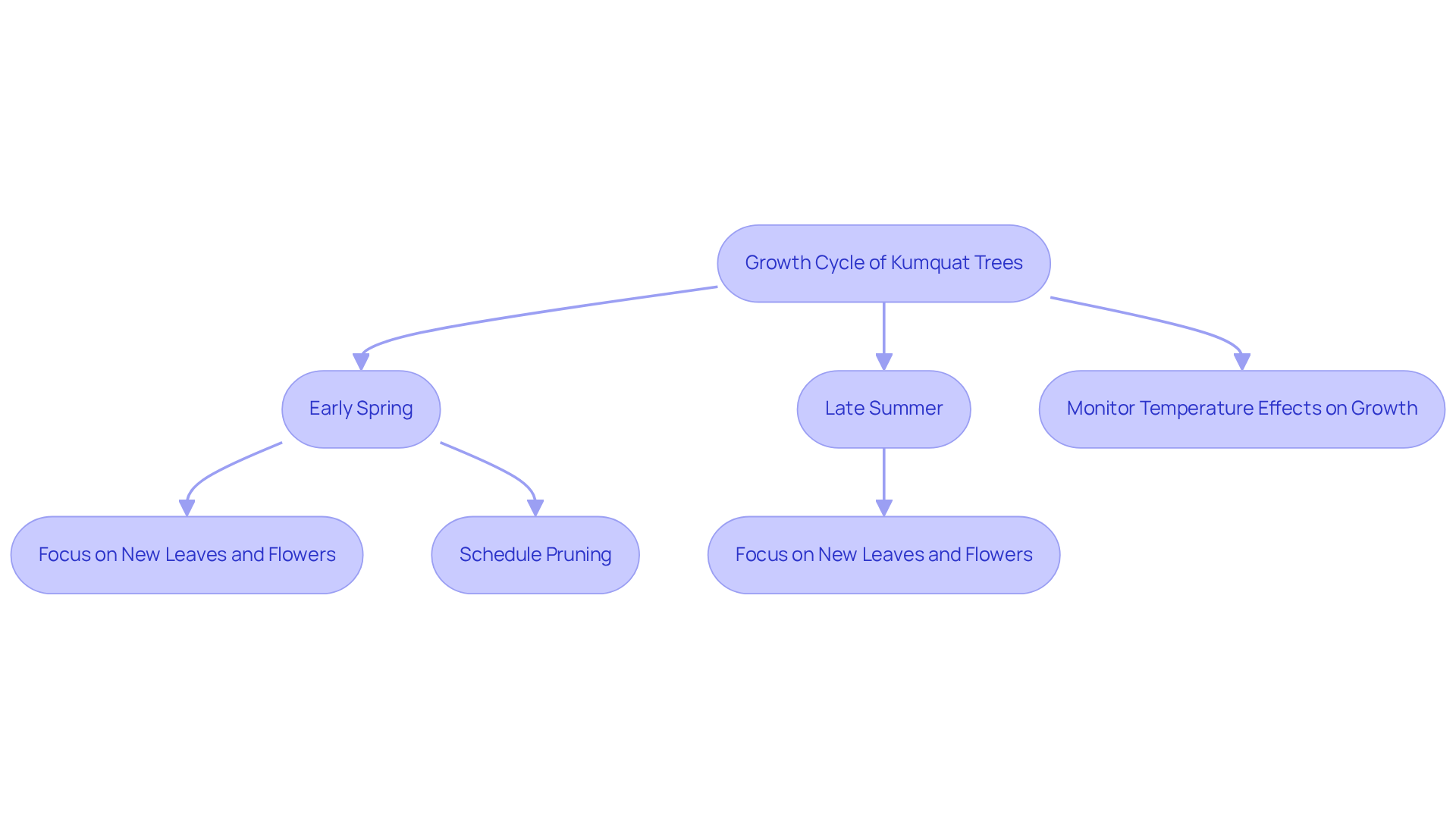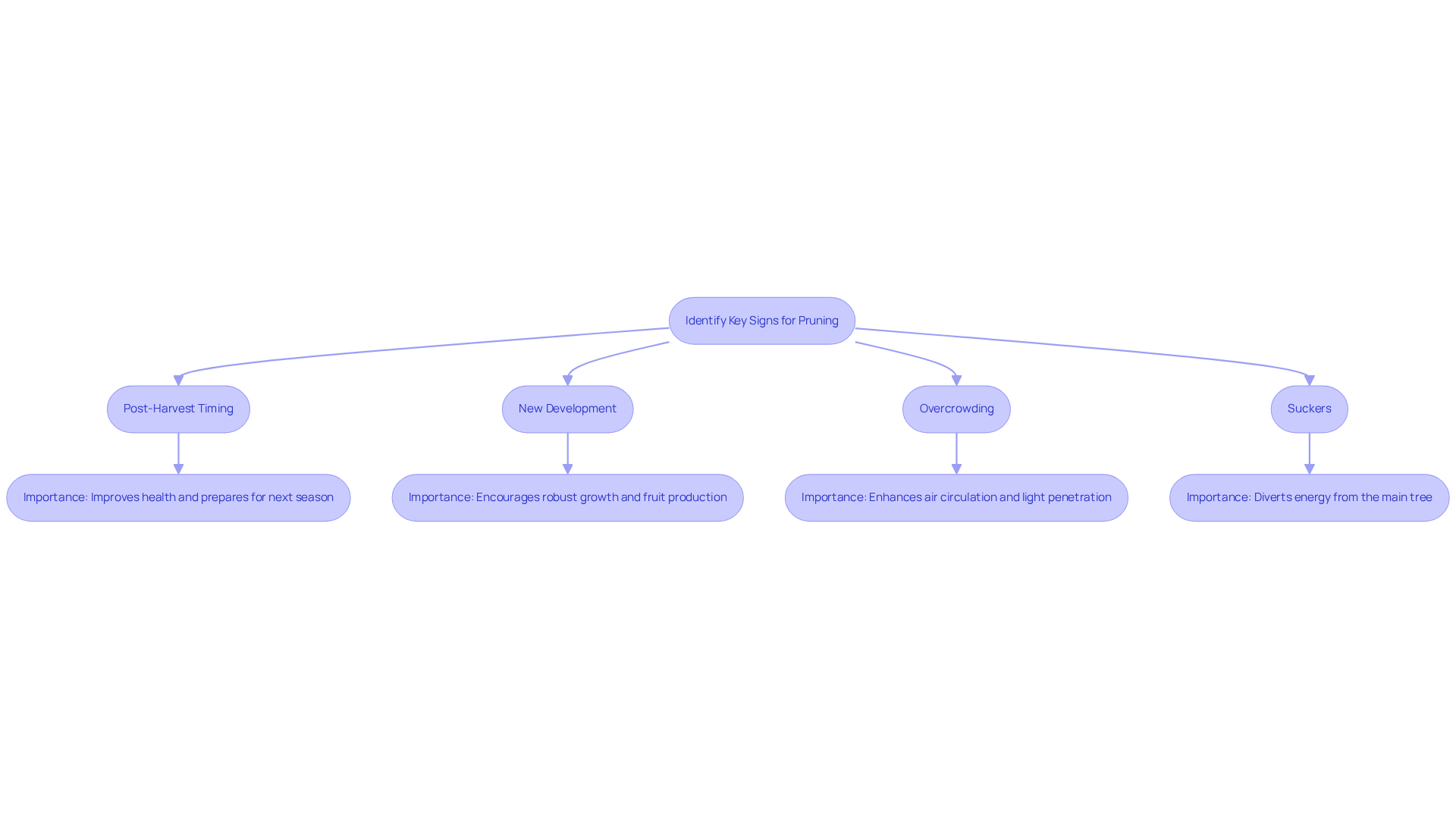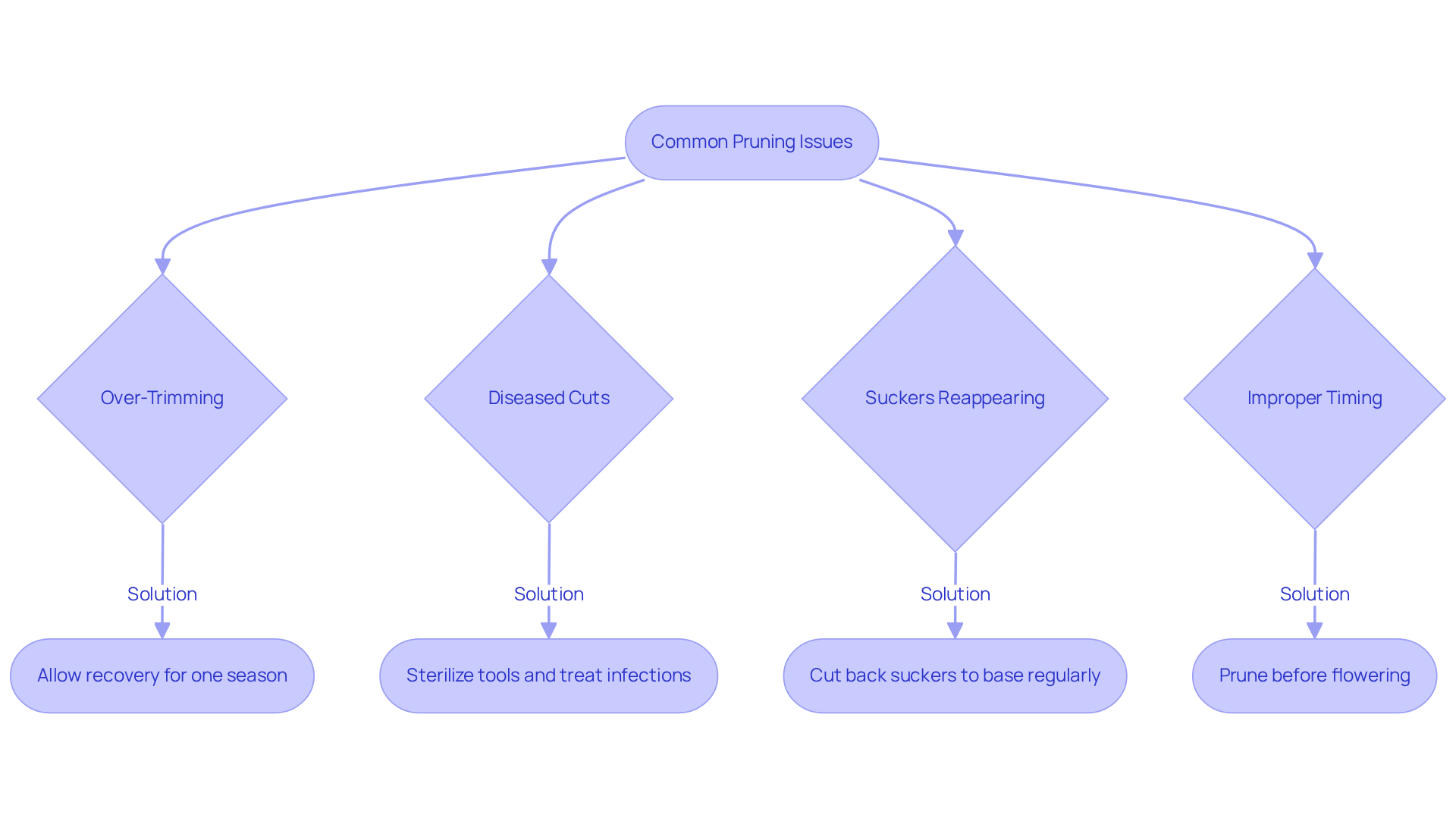
When to Prune Kumquat Tree: Key Signs and Techniques
Share
Understanding the intricate growth cycles of kumquat trees is essential for any gardener aiming to cultivate these unique citrus plants successfully. These trees exhibit distinct blooming phases and require timely pruning to thrive. Mastering the art of kumquat tree care not only enhances the health of the tree but also significantly boosts its yield.
However, many enthusiasts grapple with the critical question: when is the optimal moment to prune without jeopardizing the tree’s productivity? This guide delves into the key signs and best practices for pruning kumquat trees, ensuring they thrive and flourish throughout the growing season.
Understand the Growth Cycle of Kumquat Trees
Kumquat plants exhibit a slow development rate, making it essential to comprehend their blooming cycles. These plants typically undergo two main bursts of development:
- One in early spring
- Another in late summer
During these phases, the plant focuses on producing new leaves and flowers. Recognizing this cycle allows you to determine when to prune kumquat tree, which should occur just before the spring flush. Knowing when to prune kumquat tree is crucial as this strategic timing enables the plant to recover swiftly and encourages vigorous growth throughout the growing season.
Additionally, knowing that these small citrus fruits can produce yield in the autumn and winter aids in scheduling your trimming to avoid removing developing fruit buds. Remember that development invariably involves some trimming, and aligning your trimming efforts with these developmental stages can enhance the overall vitality and productivity of your citrus plants.
Moreover, it's important to consider the influence of temperature on growth; elevated temperatures can trigger flowering and impact growth cycles, making it vital to monitor environmental conditions as you plan your pruning schedule.

Identify Key Signs for Pruning Timing
Key signs indicating it's time to prune your kumquat tree include:
- Post-Harvest Timing: After gathering fruit, examine the plant for any dead or damaged branches that require removal. This practice not only improves the plant's health but also readies it for the next growing season.
- New Development: Early spring is the perfect season to shape your kumquat plant, as new sprouts appear. Pruning during this period encourages robust development and fruit production.
- Overcrowding: If branches are crossing or densely packed, thinning them out is essential. This enhances air circulation and light penetration, which are crucial for healthy development and fruiting.
- Suckers: Remove any suckers or water sprouts that divert energy from the main tree. These unwanted growths can hinder the overall vitality of your fruit.
Additionally, these small citrus fruits thrive best in a soil pH of 6-7.5, which supports their overall health. As noted by gardening experts, "trimming plants causes their roots to drive deeper in the ground and ultimately produce a stronger plant." By recognizing these signs and understanding broader care practices, including when to prune kumquat tree and fertilization every 4-6 weeks during the growing season, you can determine the optimal timing for effective trimming. This ensures your citrus plant remains healthy and productive.

Follow Best Practices for Pruning Techniques
- Use Clean Tools: Always use sharp, clean cutting shears to make precise cuts and prevent disease transmission. As Francis Bacon observed, innate talents need refinement through study, highlighting the significance of utilizing the appropriate tools for citrus care.
- Make Strategic Cuts: Focus on removing dead or diseased branches first. Then, thin out crowded areas to allow light and air to reach the inner branches, which enhances overall health and reduces pest problems.
- Cut at an Angle: Make cuts at a 45-degree angle just above a leaf node to promote new development and prevent water accumulation on the cut surface.
- Limit Trimming: Since kumquat plants do not require extensive cutting back, aim to remove no more than 20% of the foliage at once to avoid stressing the plant.
- Timing: Perform pruning in late winter or early spring, just before the new growth begins. This timing is crucial as it enables the plant to heal and flourish, ensuring a strong growing season ahead.
Additionally, remember to fertilize your citrus plant every 4-6 weeks during the growing season to support its health and productivity. By following these techniques, you can significantly enhance the health and productivity of your citrus plant.

Troubleshoot Common Pruning Issues
Common problems that may occur during kumquat plant trimming include:
-
Over-Trimming: Excessive cutting can lead to stunted growth and reduced fruit yield. Statistics suggest that excessively pruned plants may yield considerably fewer fruits, with some research demonstrating a decrease in production of up to 30%. Moreover, cutting lengths of 30 cm have been shown to yield the highest quantity of blossoms and fruits, highlighting the significance of appropriate trimming methods. To remedy excessive trimming, allow the tree to recover for a season without further cutting, promoting new growth. As Leonard Sweet wisely noted, 'No one enjoys the process of trimming and the pain of loss, but fruit only develops on new wood.'
-
Diseased Cuts: If you notice indications of illness on cut branches, it’s essential to ensure your trimming tools are sterilized before use. Treat any infected areas with appropriate fungicides to prevent further spread.
-
Suckers Reappearing: Persistent suckers can be a nuisance. Ensure you are cutting them back to the base during each pruning session. Regular monitoring and removal are essential to keep these growths in check.
-
Improper timing regarding when to prune kumquat tree, such as during the flowering period, can stress the plant and negatively affect fruit yield. It is important to know when to prune kumquat tree, ideally before the flowering season begins, to maintain optimal health and productivity.
By addressing these issues promptly, you can ensure your kumquat tree remains healthy and productive, maximizing its fruiting potential.

Conclusion
Understanding the optimal timing and techniques for pruning kumquat trees is essential for fostering healthy growth and maximizing fruit yield. By aligning pruning efforts with the tree's growth cycles, particularly before the spring flush, gardeners can ensure their kumquat trees thrive and produce abundantly. Recognizing the signs that indicate when to prune, such as post-harvest assessments and the appearance of new growth, allows for strategic interventions that promote the plant's vitality.
Key insights discussed include:
- The importance of using clean tools
- Making precise cuts
- Adhering to best practices to prevent over-trimming, which can hinder growth and reduce fruit production
- Monitoring for common issues like diseased cuts and persistent suckers, which is vital for maintaining the overall health of the tree
By following these guidelines, kumquat tree care becomes a more informed and effective process.
Ultimately, successful kumquat tree pruning not only enhances the health and productivity of the plant but also enriches the gardening experience. Embracing these techniques and understanding the growth patterns will empower gardeners to cultivate flourishing kumquat trees. Take proactive steps in your gardening journey by implementing these pruning strategies, ensuring your kumquat trees yield the best fruit possible.
🌱 Prune Your Way to Kumquat Success!
Unlock the secrets to thriving trees and bountiful harvests—start your gardening journey today!
Frequently Asked Questions
What is the growth cycle of kumquat trees?
Kumquat trees exhibit a slow development rate with two main bursts of growth: one in early spring and another in late summer. During these times, the plants focus on producing new leaves and flowers.
When should I prune my kumquat tree?
Pruning should occur just before the spring flush, which is the early spring growth phase. This timing allows the plant to recover quickly and encourages vigorous growth throughout the growing season.
Why is the timing of pruning important for kumquat trees?
Proper timing of pruning is crucial because it helps avoid removing developing fruit buds, as kumquat trees can yield fruit in the autumn and winter. Pruning in alignment with the growth cycles enhances the vitality and productivity of the trees.
How does temperature affect the growth of kumquat trees?
Elevated temperatures can trigger flowering and impact the growth cycles of kumquat trees. Therefore, it is important to monitor environmental conditions when planning your pruning schedule.


